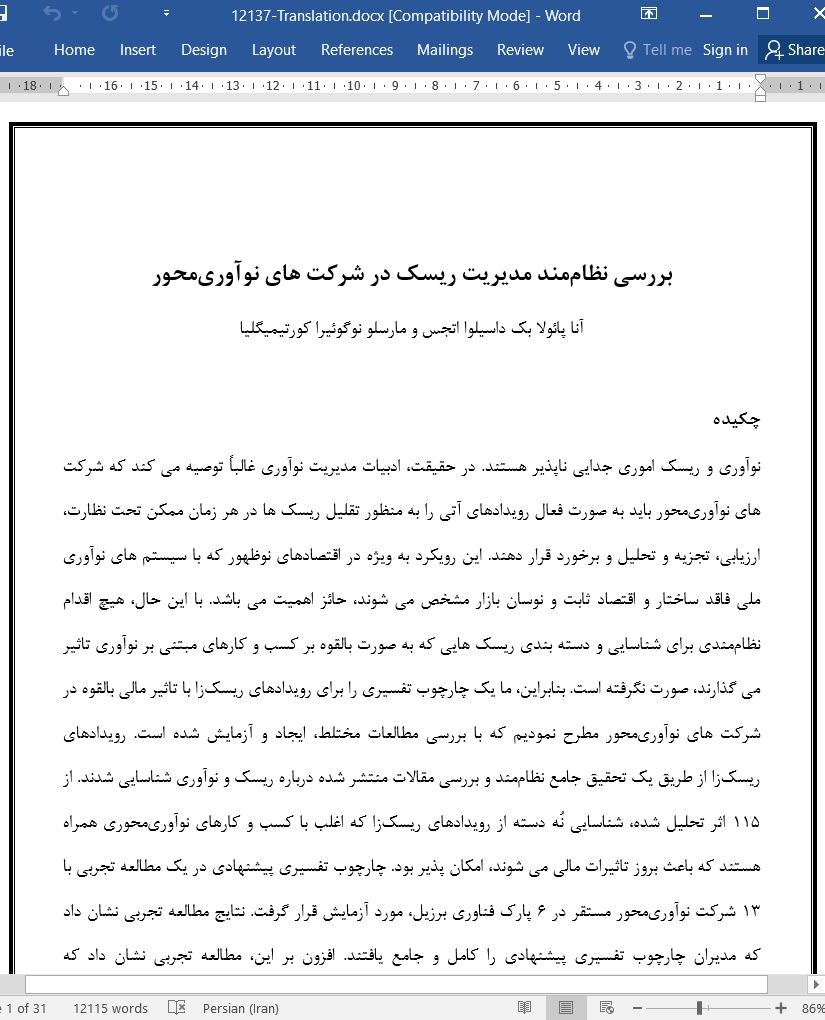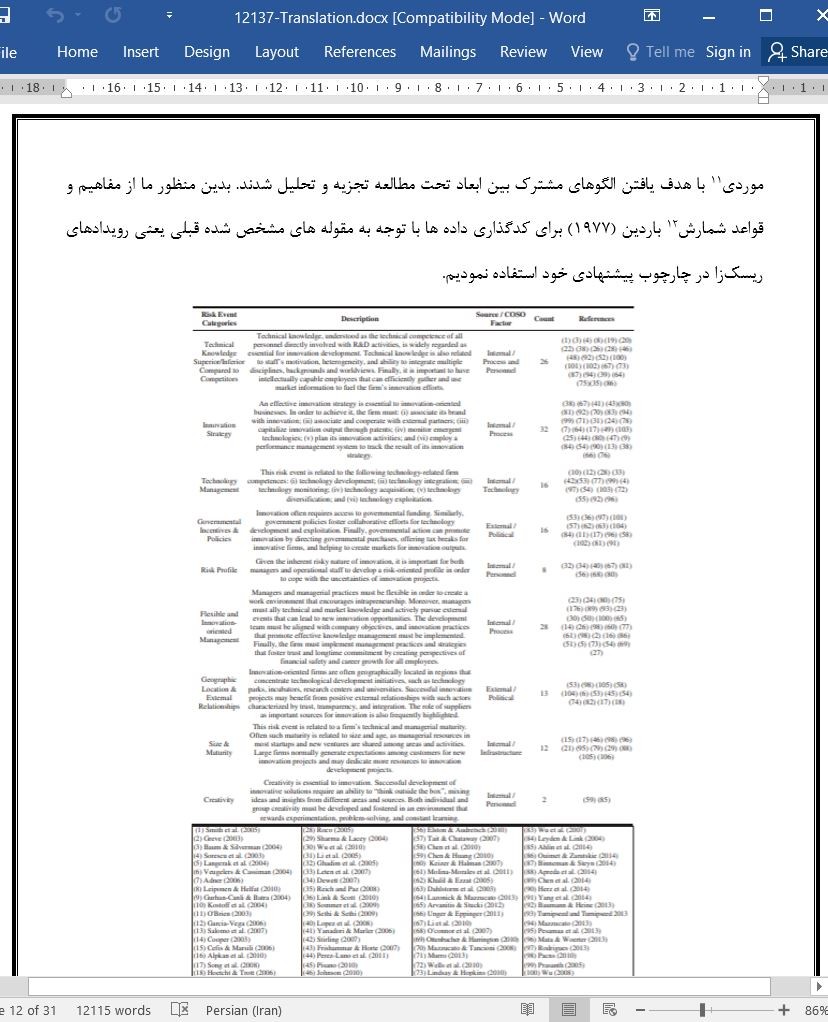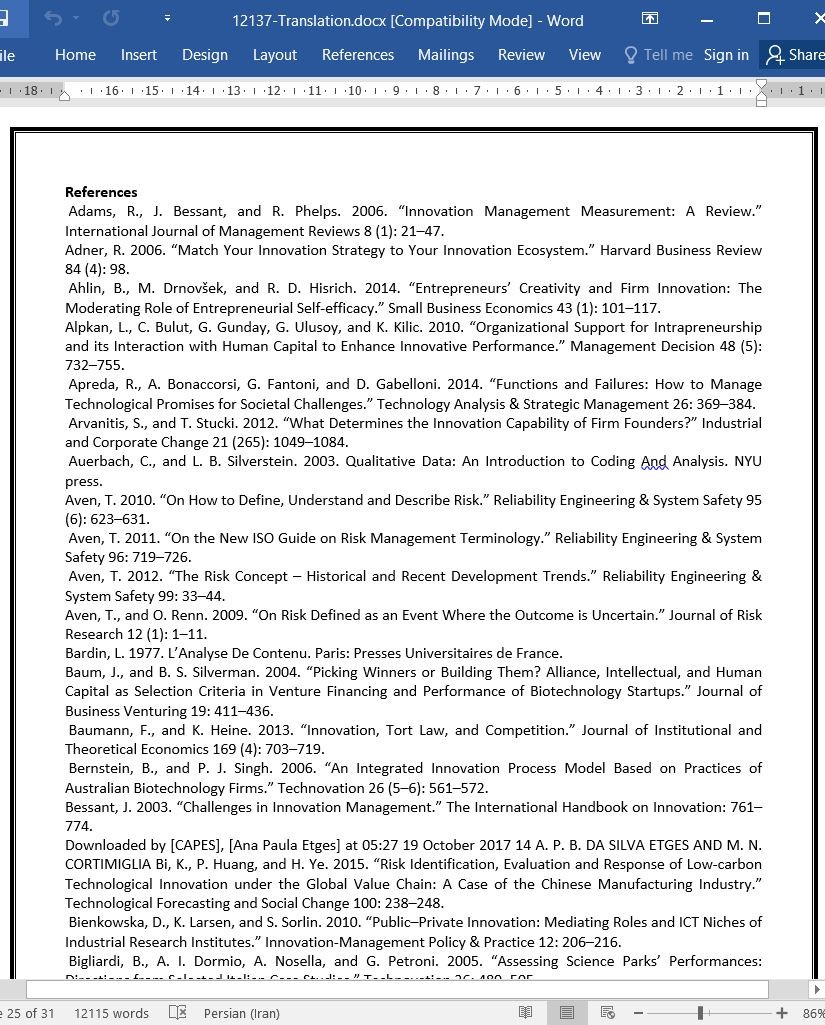
بررسی نظام مند مدیریت ریسک در شرکت های نوآوری محور
چکیده
نوآوری و ریسک اموری جدایی ناپذیر هستند. در حقیقت، ادبیات مدیریت نوآوری غالباً توصیه می کند که شرکت های نوآوریمحور باید به صورت فعال رویدادهای آتی را به منظور تقلیل ریسک ها در هر زمان ممکن تحت نظارت، ارزیابی، تجزیه و تحلیل و برخورد قرار دهند. این رویکرد به ویژه در اقتصادهای نوظهور که با سیستم های نوآوری ملی فاقد ساختار و اقتصاد ثابت و نوسان بازار مشخص می شوند، حائز اهمیت می باشد. با این حال، هیچ اقدام نظاممندی برای شناسایی و دسته بندی ریسک هایی که به صورت بالقوه بر کسب و کارهای مبتنی بر نوآوری تاثیر می گذارند، صورت نگرفته است. بنابراین، ما یک چارچوب تفسیری را برای رویدادهای ریسکزا با تاثیر مالی بالقوه در شرکت های نوآوریمحور مطرح نمودیم که با بررسی مطالعات مختلط، ایجاد و آزمایش شده است. رویدادهای ریسکزا از طریق یک تحقیق جامع نظاممند و بررسی مقالات منتشر شده درباره ریسک و نوآوری شناسایی شدند. از 115 اثر تحلیل شده، شناسایی نُه دسته از رویدادهای ریسکزا که اغلب با کسب و کارهای نوآوریمحوری همراه هستند که باعث بروز تاثیرات مالی می شوند، امکان پذیر بود. چارچوب تفسیری پیشنهادی در یک مطالعه تجربی با 13 شرکت نوآوریمحور مستقر در 6 پارک فناوری برزیل، مورد آزمایش قرار گرفت. نتایج مطالعه تجربی نشان داد که مدیران چارچوب تفسیری پیشنهادی را کامل و جامع یافتند. افزون بر این، مطالعه تجربی نشان داد که رویدادهای ریسکزا برای بافت برزیل تناسب بیشتری دارند. چارچوب پیشنهادی نخستین گام لازم در راستای توسعه آتی مدل های ERM قابل اجرا در زمینه های نوآوریمحور شمرده می شود.
1. مقدمه
از دهه 1960، مطالعات نوآوری از یک دلبستگی تحقیقاتی جزئی در علوم اجتماعی به یک پدیده جهانی و چندوجهی تکامل یافته و از دیدگاه های تحقیقاتی متعددی می توان بدان پرداخت که زمینه ساز گفتمان استراتژیک درباره رقابت و بهره وری در سطح شرکت، منطقه، و کشور می باشد (فاگربرگ و ورسپاگن، 2009؛ فاگربرگ، فوساس و ساپریزرت، 2012). تعاریف متعددی برای نوآوری در گذر زمان ارائه شده که از مفاهیم فراگیری مانند دگرگونی اجتماعی – فناوری نسل ها و نوآوری سیستمی (الزن و وایچورک، 2005) تا تعاریف عملیاتی بسیار ویژه مانند نوآوری مدیریتی (دامان پور و آراویند، 2011) را در بر می گیرد. در مقاله حاضر، ما زمینه حد واسط را انتخاب نموده و توجه خود را معطوف نوآوری در سطح شرکت نمودیم. اغلب تحقیقات کاربردی درباره نوآوری در سطح شرکت آن را با تبدیل فرصت های کسب و کار به ارزش واقعی مرتبط می دانند؛ بدین ترتیب، نوآوری می تواند هم فرآیند باشد و هم برونداد (کراسن و اپیدین، 2010؛ ناگانو، استفانوویتز و ویک، 2014). افزون بر این تعریف نوآوری، فرضیات تحقیق حاضر عبارتند از: (1) این حقیقت که نوآوری و عدم قطعیت عملاً امری جدایی ناپذیر هستند (بیسانت، 2003؛ آدامز، بیسانت و فلپس، 2006؛ هاوسر، تلیس و گریفین، 2006؛ وونگ و چین، 2007)، و (2) این فرض که طریقه نگرش و برخورد شرکت ها با عدم قطعیت (و متعاقباً ریسک ها) بر تصمیم گیری مربوط به نوآوری تاثیر می گذارد (مایجر و همکاران، 2006).
ABSTRACT
Innovation and risk are inseparable. In fact, literature on innovation management often recommends that innovation-oriented firms must actively monitor, evaluate, analyze and treat future events in order to mitigate risks whenever possible. This approach is particularly important in emergent economies characterized by unstructured national innovation systems and constant economic and market instability. However, there has been no systematic effort to identify and categorize risks that potentially impact businesses based on innovation. Thus, we propose an interpretative framework of risk events with potential financial impact in innovationoriented firms constructed and tested by means of a mixed studies review. The risk events were identified through a comprehensive systematic search and review of the published literature on risk and innovation. From the 115 works that were analyzed, it was possible to identify nine categories of risk events frequently associated with innovation-oriented businesses that may generate financial impacts. The proposed interpretative framework was tested in an empirical study with 13 innovation-oriented firms located in six Brazilian technological parks. Results from the empirical study suggest that managers found the proposed interpretative framework complete and comprehensive. Moreover, the empirical study signaled which risk events are more relevant for the Brazilian context. The proposed framework is a first necessary step for future development of ERM models applicable in innovation-intensive contexts.
1. Introduction
Since the 1960s, innovation studies have evolved from a minor research interest in social sciences into a global, multifaceted phenomenon approached from multiple research perspectives that drives the strategic discourse on competition and productivity at the firm, region, and nation levels (Fagerberg and Verspagen 2009; Fagerberg, Fosaas, and Sapprasert 2012). Multiples definitions of innovation have been proposed over time, ranging from wide encompassing concepts such as generational socio-technological transformation and system innovation (Elzen and Wieczorek 2005; Geels 2005) to very specific operational definitions such as managerial innovation (Damanpour and Aravind 2011). In this paper, we opt for the middle ground, and focus our attention to innovation at the firm level. Most applied research about innovation at the firm level associate it with transformation of business opportunities into actual value; as such, innovation can be both a process and an outcome (Crossan and Apaydin 2010; Nagano, Stefanovitz, and Vick 2014). In addition to this definition of innovation, the premises of this research are: (i) the fact that innovation and uncertainty are virtually inseparable (Bessant 2003; Adams, Bessant, and Phelps 2006; Hauser, Tellis, and Griffin 2006; Wong and Chin 2007), and (ii) the assumption that the way firms view and treat uncertainty (and, consequently, risks) impacts innovation-related decision-making (Meijer et al. 2006).
چکیده
1. مقدمه
2. روندهای روش شناختی
2.1. بررسی ادبیات نظاممند
2.2. مطالعه اکتشافی چندموردی
3. نتایج و بحث
3.1. چارچوب تفسیری رویدادهای ریسکزا برای شرکت های نوآوریمحور
3.2. اعتبارسنجی رویداد ریسکزا
4. نتیجه گیری
منابع
ABSTRACT
1. Introduction
2. Methodological procedures
2.1. The systematic literature review
2.2. Exploratory multiple case-study
3. Results and discussion
3.1. Interpretative framework of risk events for innovation-oriented firms
3.2. Risk event validation
4. Conclusions
References
- اصل مقاله انگلیسی با فرمت ورد (word) با قابلیت ویرایش
- ترجمه فارسی مقاله با فرمت ورد (word) با قابلیت ویرایش، بدون آرم سایت ای ترجمه
- ترجمه فارسی مقاله با فرمت pdf، بدون آرم سایت ای ترجمه



